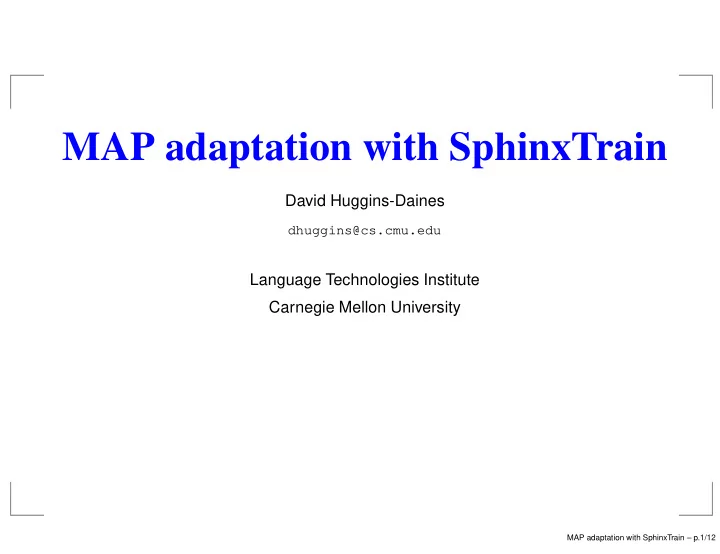

MAP adaptation with SphinxTrain David Huggins-Daines dhuggins@cs.cmu.edu Language Technologies Institute Carnegie Mellon University MAP adaptation with SphinxTrain – p.1/12
Theory of MAP adaptation Standard Baum-Welch training produces a maximum-likelihood estimate of model parameters λ : λ ML = arg max P ( O | λ ) λ MAP training produces the maximum a-posteriori estimate: λ MAP = arg max P ( O | λ ) P ( λ ) λ Reduces to ML estimate with a non-informative prior P ( λ ) . For speaker adaptation, the prior P ( λ ) is derived from a baseline or speaker-independent model. MAP adaptation with SphinxTrain – p.2/12
MAP adaptation in practice The simplest method is Bayesian updating of each Gaussian mean, assuming the following (incorrect) prior: µ ∼ N ( µ SI , σ 2 SI ) This reduces to interpolation between SI parameters and ML (forward-backward) estimates from the adaptation data: � T t =1 γ t ( i, k ) σ 2 SI µ ML + σ 2 ML µ SI µ MAP = ˆ � T t =1 γ t ( i, k ) σ 2 SI + σ 2 ML The posterior variance can also be computed, but it is not useful. MAP adaptation with SphinxTrain – p.3/12
MAP adaptation in practice With a more detailed prior, all HMM/GMM parameters can be updated. This is important for semi-continuous models since the mixture weights can be modified. Prior is a product of a Dirichlet distribution with hyperparameters { η, ν } and a Gamma-Normal distribution with hyperparameters { α, β, µ, τ } . The τ hyperparameter controls the “speed” of adaptation. Larger τ = less adaptation. Estimation of these hyperparameters is tricky. Generally, τ is estimated, then all other hyperparameters derived from it and the SI model. MAP adaptation with SphinxTrain – p.4/12
MAP adaptation in practice The τ can be fixed to a global value (e.g. 2.0) or it can be estimated separately for each Gaussian: p � T t =1 γ t ( i, k ) τ ik = � T µ ik − µ ik ) T ( w ik Σ ik )(ˆ t =1 γ t ( i, k )(ˆ µ ik − µ ik ) � K ν ik is then estimated as w ik k =1 τ ik and the mixture weights are re-estimated as: ν ik − 1 + � T t =1 γ t ( i, k ) w ik = ˆ � K k =1 ν ik − K + � K � T t =1 γ t ( i, k ) k =1 MAP adaptation with SphinxTrain – p.5/12
MAP with SphinxTrain MAP interpolation and updating has been implemented in SphinxTrain as the map_adapt tool. It works similarly to the norm tool, except that it produces a MAP re-estimation rather than an ML one. 1. Collect forward-backward statistics on adaptation data using the baseline models and bw . 2. Run map_adapt the same way you would norm , specifying the baseline model files and the output MAP model files. Works for continuous and semi-continuous models. (SCHMM is broken in current version but I’ll fix it). MAP adaptation with SphinxTrain – p.6/12
Combining MAP and MLLR In theory they are equivalent, if each Gaussian has its own regression class. In practice, this never happens, and their effects are additive. To combine them: 1. Compute an MLLR transformation with bw and mllr_solve 2. Apply it to the baseline means with mllr_transform 3. Re-run bw with the transformed means 4. Run map_adapt to produce a MAP re-estimation MAP adaptation with SphinxTrain – p.7/12
Unsupervised MAP This doesn’t work. Don’t do it. The lack of parameter tying in the standard MAP algorithm means that the adaptation is not robust. Incorrect transriptions of adaptation data result in the wrong models being updated. MLLR alone is a better choice for sparse or noisy adaptation data. MAP adaptation with SphinxTrain – p.8/12
MAP results on RM1 (CDHMM) 1000 CD senones, 8 gaussians, Sphinx 3.x fast decoder Speaker Baseline 100 200 400 MLLR+400 Relative bef0_3 10.40% 8.43% 7.75% 7.75% 7.84% -24.62% cmr0_2 8.78% 6.66% 6.40% 6.40% 4.66% -46.92% das1_2 9.73% 7.04% 5.92% 4.75% 4.21% -56.73% dms0_4 8.31% 5.66% 5.48% 5.01% 4.42% -46.81% dtb0_3 9.43% 7.49% 6.63% 5.84% 5.10% -45.92% ers0_7 8.19% 7.93% 7.96% 6.34% 5.92% -27.72% hxs0_6 16.36% 11.14% 11.08% 7.52% 7.22% -55.87% jws0_4 8.81% 6.90% 6.69% 6.40% 5.69% -35.41% pgh0_1 7.84% 6.37% 6.54% 5.13% 5.04% -35.71% rkm0_5 24.20% 17.83% 17.18% 13.82% 11.97% -50.54% tab0_7 6.51% 5.57% 5.33% 4.27% 4.30% -33.95% MAP adaptation with SphinxTrain – p.9/12
MAP results on RM1 (SCHMM) 4000 CD senones, 256 gaussians, Sphinx 3.x slow decoder Speaker Baseline MAP MLLR+MAP Relative bef0_3 8.87% 8.37% 7.87% -11.27% cmr0_2 7.10% 6.63% 6.42% -9.58% das1_2 6.07% 5.31% 4.75% -21.75% dms0_4 5.87% 5.25% 4.69% -20.10% dtb0_3 7.87% 7.13% 6.93% -11.94% ers0_7 7.10% 6.93% 6.60% -7.04% hxs0_6 10.08% 8.81% 7.60% -24.60% jws0_4 6.63% 5.92% 5.63% -15.08% pgh0_1 7.93% 7.13% 6.54% -17.53% rkm0_5 15.97% 14.09% 11.94% -25.23% tab0_7 5.89% 5.04% 4.63% -21.39% MAP adaptation with SphinxTrain – p.10/12
MAP on SRI CALO scenario meetings CALOBIG models, 5000 CD senones, 16 gaussians, Sphinx 3.x fast decoder One meeting in a sequence of five was adapted with the other four. Results were averaged for all five meetings. Speaker Baseline MLLR MLLR+MAP Best relative WER bill_deans 50.89% 47.37% 39.39% -22.60% lpound 56.54% 51.34% 38.90% -31.20% jpark 29.54% 27.71% 25.88% -12.40% MAP adaptation with SphinxTrain – p.11/12
References Chin-Hui Lee and Jean-Luc Gauvain, “Speaker Adaptation Based on MAP Estimation of HMM Parameters”. Procedings of ICASSP 1993 , pp. 558-561. Chin-Hui Lee and Jean-Luc Gauvain, “MAP Estimation of Continuous Density HMM: Theory and Applications”. Proceedings of DARPA Speech & Nat. Lang. 1992 . Qiang Huo and Chorkin Chan, “Bayesian Adaptive Learning of the Parameters of Hidden Markov Model for Speech Recognition”. IEEE Transactions on Speech and Audio Processing , 3:5, pp. 334-345. MAP adaptation with SphinxTrain – p.12/12
Recommend
More recommend